Imagine a city where rain gardens flourish between buildings, where green roofs transform concrete jungles into vibrant ecosystems, and where natural water systems work in harmony with urban development. This isn’t just an environmentalist’s dream – it’s the reality emerging through innovative green infrastructure planning across North America. Green infrastructure represents a revolutionary approach to urban development, combining nature-based solutions with traditional infrastructure to create resilient, sustainable communities. By integrating living systems like wetlands, urban forests, and bioswales into our city planning, we’re not just building infrastructure – we’re cultivating healthier environments, stronger economies, and more livable communities for future generations. As cities face increasing challenges from climate change and urbanization, green infrastructure offers a powerful toolkit for creating urban spaces that work with nature, not against it. The benefits extend far beyond environmental protection, delivering substantial economic advantages through reduced maintenance costs, enhanced property values, and improved public health outcomes.
Natural Heritage Meets Modern Conservation
What Makes Ontario’s Landscape Unique
Ontario’s remarkable landscape tells a story spanning billions of years, shaped by ancient glaciers and geological forces. The iconic Niagara Escarpment, a UNESCO World Biosphere Reserve, stretches 725 kilometers across the province, offering breathtaking cliff faces and scenic lookouts that draw millions of visitors annually.
The Canadian Shield’s exposed bedrock creates a stunning mosaic of lakes, forests, and rocky outcrops, perfect for hiking and photography. Our Great Lakes shorelines, the longest freshwater coastal system in the world, provide endless opportunities for beach activities and waterfront adventures.
The Carolinian forests in southern Ontario represent Canada’s most diverse ecosystem, while the Hudson Bay Lowlands in the north form North America’s largest wetland. These distinct features not only make Ontario a photographer’s paradise but also support various recreational activities year-round, from rock climbing to birdwatching.
What makes these landscapes truly special is their accessibility – you can experience world-class natural wonders just a short drive from major urban centers.
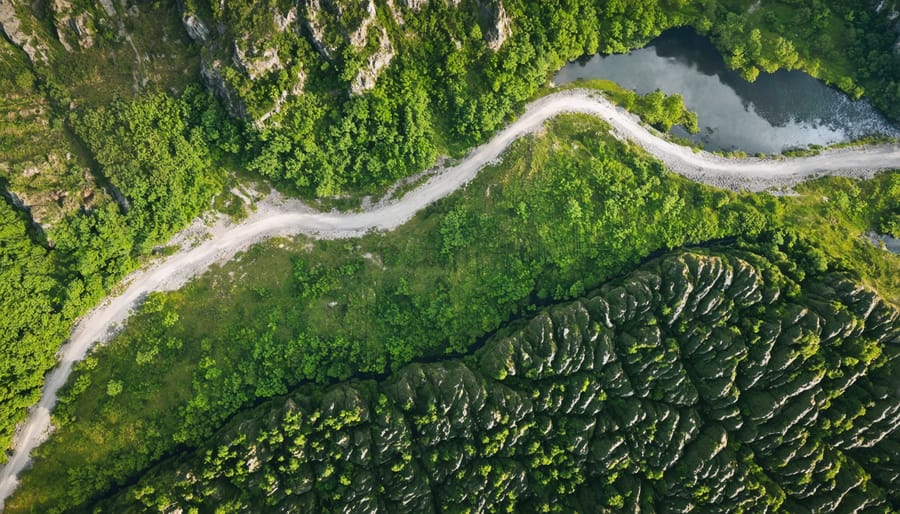
Balancing Access with Protection
Ontario’s green infrastructure planning strikes a delicate balance between welcoming visitors and protecting our natural treasures. Trail systems are thoughtfully designed with designated viewing areas that offer stunning vistas while keeping sensitive ecosystems off-limits. Natural barriers like strategic plantings and elevated boardwalks guide visitors along safe paths while preserving delicate ground cover and wildlife habitats.
Visitor centers are positioned at key entry points, providing educational resources and clear guidelines for responsible exploration. These facilities help manage foot traffic and ensure everyone understands their role in preservation. During peak seasons, some areas implement timed entry systems to prevent overcrowding and maintain the quality of visitor experiences.
Smart design solutions, like permeable parking lots and rain gardens, help manage environmental impact while accommodating necessary tourism infrastructure. By carefully planning these elements, Ontario’s natural areas remain accessible for today’s visitors while ensuring they stay pristine for future generations to enjoy.
Smart Design in Action
Eco-Friendly Trail Systems
Ontario’s sustainable trail networks showcase how thoughtful design can protect our precious geological features while offering unforgettable outdoor experiences. By incorporating elevated boardwalks and strategically placed viewing platforms, these trails prevent erosion and protect sensitive root systems while giving visitors amazing vantage points of our natural wonders.
Natural materials like locally sourced stone and wood are used to create paths that blend seamlessly with the environment. These materials not only reduce the ecological footprint but also provide better traction and durability in various weather conditions. Clever water management features, including permeable surfaces and natural drainage systems, help prevent trail washout while protecting surrounding vegetation.
Trail designers work closely with geologists and environmental experts to identify sensitive areas and rare formations. This collaboration results in routes that guide visitors away from fragile ecosystems while still offering excellent views and photo opportunities. Educational signage along the trails helps visitors understand why certain areas are protected and how their responsible trail use contributes to preservation efforts.
Many trails now incorporate rest areas with natural seating made from fallen logs or local stone, providing comfortable spots to pause without disturbing the landscape. These thoughtful touches encourage visitors to take their time, appreciate their surroundings, and minimize their impact on the environment.
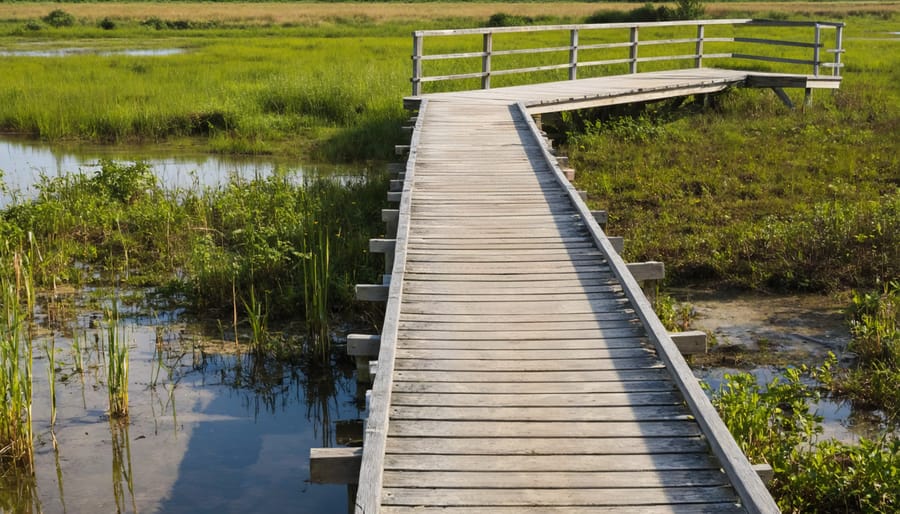
Visitor Facilities That Work With Nature
Ontario’s green infrastructure showcases how visitor facilities can harmoniously blend with the natural environment. Take the Niagara Parks Butterfly Conservatory, for example, where living roofs not only provide habitat for local wildlife but also help regulate indoor temperatures naturally. The building’s design incorporates large windows that maximize natural light while strategic positioning minimizes energy needs.
At the Bruce Peninsula National Park, elevated boardwalks protect delicate ecosystems while giving visitors intimate access to unique geological formations and rare flora. These carefully engineered pathways allow water to flow naturally underneath, preserving the wetland’s vital functions while offering stunning viewpoints of Georgian Bay.
The Kortright Centre for Conservation demonstrates how modern amenities can work with nature through its solar-powered visitor center and permeable parking lots that filter rainwater naturally. Educational signs along the trails explain how these green solutions benefit both visitors and local wildlife.
In Algonquin Park, comfort stations use composting toilets and grey-water recycling systems, while viewing platforms are constructed with sustainable materials that weather naturally into the landscape. These thoughtful designs show how infrastructure can enhance rather than detract from the wilderness experience.
Look for facilities featuring local materials, like the limestone-faced welcome centers in the Thousand Islands region, or the reclaimed timber structures at Pinery Provincial Park. These choices reduce transportation impacts while celebrating Ontario’s natural heritage.
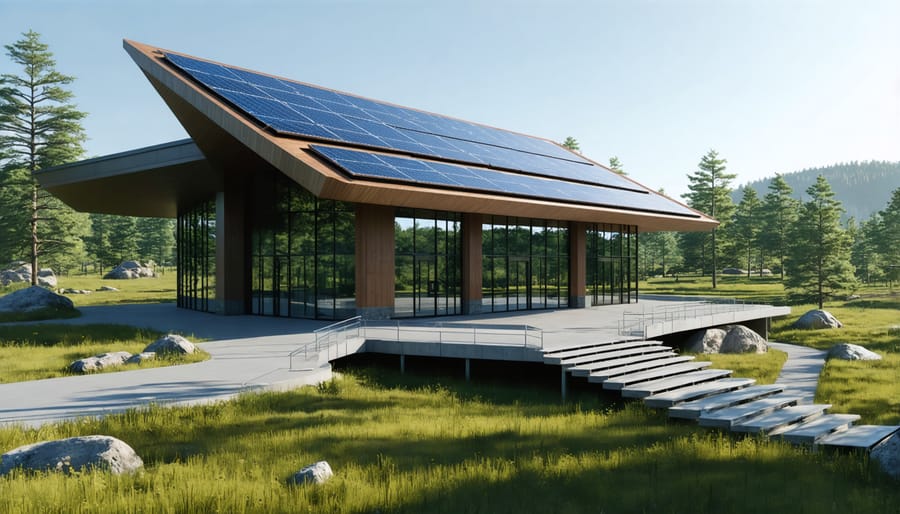
Planning Your Visit Responsibly
Best Times to Visit
Ontario’s green infrastructure is best experienced throughout different seasons, each offering unique perspectives on sustainable development and natural preservation. Spring (April-May) brings optimal conditions for witnessing new growth and observing how green roofs and bioswales manage snowmelt and rainfall. This season also presents fewer crowds, allowing for more intimate exploration of eco-friendly installations.
Summer months (June-August) showcase living walls and urban gardens in full bloom, though it’s best to visit early morning or evening to avoid peak heat and energy usage. Fall (September-October) offers comfortable temperatures and stunning foliage, making it perfect for exploring green corridors and wildlife passages. The changing colors provide excellent photography opportunities of naturalized stormwater management systems.
Winter (December-February) reveals how green infrastructure adapts to harsh conditions, particularly in managing snow and ice. While some features may be dormant, this season demonstrates the year-round functionality of sustainable design. For the most enriching experience, consider visiting during shoulder seasons (spring and fall) when moderate temperatures and reduced tourism pressure allow for minimal environmental impact while maximizing visibility of green initiatives.
Pro tip: Schedule your visit during weekdays or off-peak hours to reduce strain on local resources and enjoy more peaceful exploration of these innovative environmental solutions.
Eco-Conscious Visitor Tips
Help us protect Ontario’s natural wonders by following these essential eco-friendly guidelines during your visit. Practice responsible park visitation by staying on marked trails to prevent erosion and protect delicate vegetation. Pack reusable water bottles and containers, and always follow the “leave no trace” principle by taking all waste with you.
Consider using public transportation or carpooling to reduce your carbon footprint when visiting our parks. If you’re bringing snacks, opt for locally sourced products with minimal packaging. Wildlife watching? Remember to maintain a safe distance and never feed the animals – this helps preserve their natural behaviors and keeps both you and them safe.
Photographers, please avoid disturbing natural areas for the perfect shot. Instead, capture nature’s beauty from designated viewing areas. During peak seasons, try visiting during off-hours to reduce crowding and minimize impact on the environment. By being mindful visitors today, we ensure these precious spaces remain vibrant for future generations to enjoy.
Looking to give back? Consider joining local conservation efforts or participating in organized clean-up events at your favorite parks.
Future-Proofing Our Natural Heritage
Ontario’s commitment to preserving our natural heritage is taking a bold step forward with innovative green infrastructure initiatives planned for the next decade. These projects aren’t just about maintaining what we have – they’re about creating a sustainable future that benefits both our environment and our communities.
A network of urban forests is being developed across major cities, with native species selected specifically for their ability to thrive in our changing climate. These green spaces will serve as natural air filters, reduce urban heat islands, and provide crucial wildlife corridors, all while offering residents beautiful spaces for recreation and relaxation.
Our waterways are getting special attention too. New bioswales and rain gardens are being integrated into existing storm management systems, helping to naturally filter rainwater while creating stunning landscape features. These innovations will protect our water quality while reducing flood risks in urban areas.
Perhaps most exciting is the planned expansion of green roofs and living walls throughout our business districts. These vertical gardens won’t just make our cities more beautiful – they’ll help reduce energy costs, support local biodiversity, and create new spaces for urban agriculture.
Looking ahead, we’re implementing smart technology to monitor and maintain these green spaces more efficiently. Solar-powered sensors will track soil moisture levels, air quality, and wildlife movement patterns, helping us make data-driven decisions about resource management.
These initiatives are designed with community involvement in mind. Local volunteer programs and educational workshops will help residents learn about and participate in maintaining these green spaces, creating a sense of ownership and connection to our natural heritage.
Through these forward-thinking projects, we’re not just preserving our environment – we’re enhancing it for future generations to enjoy.
As visitors to Ontario’s natural spaces, each of us plays a vital role in supporting and protecting our green infrastructure. By following designated trails, properly disposing of waste, and respecting wildlife habitats, we contribute to the preservation of these precious ecosystems for future generations. Consider joining local conservation groups, participating in volunteer clean-up events, or supporting eco-tourism initiatives that reinvest in our natural areas.
Small actions make a big difference – from carrying reusable water bottles to choosing eco-friendly accommodations and learning about the unique geological features you’re exploring. Share your knowledge and appreciation for Ontario’s natural wonders with fellow travelers, and encourage others to embrace sustainable tourism practices.
Remember, our green spaces are more than just beautiful destinations; they’re living systems that clean our air, filter our water, and provide homes for countless species. By being mindful visitors and active supporters of green infrastructure initiatives, we ensure these natural treasures continue to thrive. Your conscious choices and responsible exploration help maintain the delicate balance between tourism enjoyment and environmental preservation, making you an essential partner in Ontario’s green future.



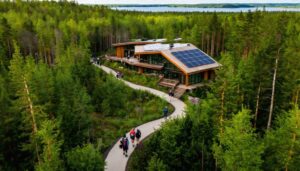





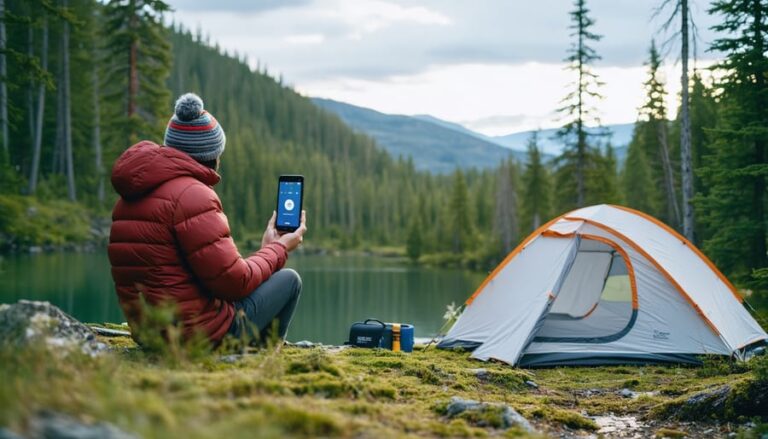




+ There are no comments
Add yours